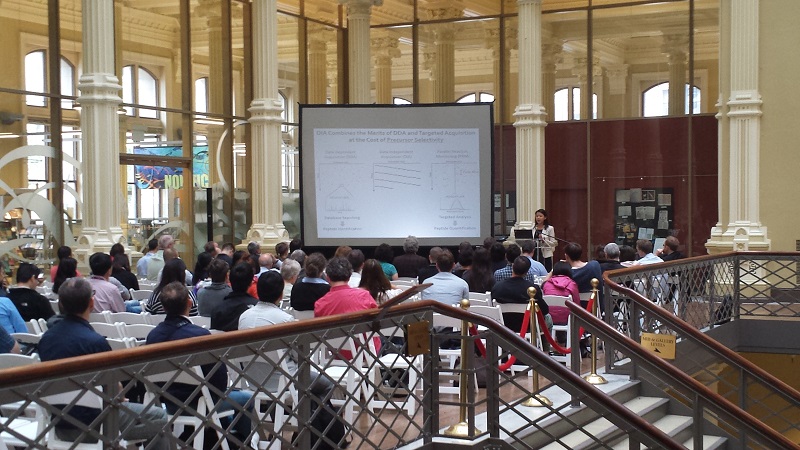Table of Contents |
guest 2024-04-16 |
Speakers
Erin Baker, Ph.D.
Jim Bollinger, Ph.D.
Bruno Domon, Ph.D.
Laura G. Dubois
Tom Dunkley Ph.D.
Sam Payne, Ph.D.
Brendan MacLean
Chris Shuford, Ph.D.
Martin Soste, M.Sc.
Sonia Ting
Event Information
Thanks!
On May 31st 2015, the fourth Skyline User Group Meeting was held at the Old Post Office in St. Louis, the day before the start of the ASMS conference. Held literally a stone's throw from the front door of ASMS at America's Center, the Old Post Office venue treated attendees to a rare surviving example of grand architectural design dating back to the post-Civil War Reconstruction Period. With 220 Skyline users in attendance, host Michael MacCoss introduced the 10 speakers, in succession, who presented on a range of topics including the latest, novel approaches to using Skyline for targeted proteomics as well as exciting new functionality in Skyline to support research into ion mobility mass spectrometry and small molecules. You are invited to review the presented material now linked at the bottom of the presenter abstract pages. Click the presentation titles below to access the presentations.
Please note: In the excitement this year, we somehow managed to mute the microphone on the video recording which made it impossible to deliver useful videos of the presentations, as we have in the past. We expect to be back with full presentation recordings next year.
Thank you very much to everyone who attended, and especially the presenters for giving your time so generously to make this fourth year such a great success!


Speakers
Ten speakers with interesting and different areas of expertise in Skyline use and development spoke at the Skyline User Group Meeting at ASMS 2015 in St. Louis, MO.
|
Erin Baker, Ph.D.
 |
Erin Baker, Ph.D., is a bioanalytical chemist with more than 14 years’ experience utilizing ion mobility spectrometry in conjunction with mass spectrometry (IMS-MS) to study biological systems. In the last 8 years she has worked primarily on IMS-MS applications in the field of proteomics and more recently she has studied IMS-MS metabolomic and lipidomic separations. Her research involves the development and evaluation of high-throughput IMS-MS, FAIMS-IMS-MS and LC-IMS-MS analyses to quickly study numerous samples in a short time period without losing valuable biological information. She has previously evaluated short LC gradients for use with IMS-MS in proteomic and lipidomic analyses, and is presently working with the Informatics team to design and implement software tools that automatically analyze the complex multidimensional data.
Utilizing Skyline to Analyze Multidimensional LC-IMS(CID)-MS DataIon mobility spectrometry (IMS) in conjunction with liquid chromatography separations and mass spectrometry offers a range of possibilities for analyzing complex biological samples. While a number of informatic tools exist to analyze LC-MS-based proteomics data, many of these tools do not have the unique requirements for analyzing the 3-dimensional LC-IMS-MS data. Over the last year, Skyline has successfully incorporated IMS information into their LC-MS analyses allowing better characterization of LC-IMS(CID)-MS data. In this presentation I will illustrate how Skyline has helped us understand the differences between acquiring LC-IMS(CID)-MS data taken in an all-ions fragmentation mode versus using a SWATH approach. [PDF] |
Jim Bollinger, Ph.D.
 |
James Bollinger, Ph.D., is a postdoctoral research fellow for Michael J. MacCoss in Department of Genome Sciences at the University of Washington. Originally from Chicago, he received a B.A. in Psychology and a B.S. in Biochemistry from the University of Missouri. After several years of working as a research scientist in an academic laboratory, he returned to graduate studies. Under the tutelage of Michael H. Gelb, he obtained a Ph.D in organic chemistry from the University of Washington. In his current position, he focuses his efforts on method development for targeted proteomic assays.
Multiplexing Clinical Protein Targets in Dried Blood SpotsIn clinical diagnostics, dried blood spot (DBS) samples have several advantages over their serum and plasma counterparts. Despite the success of DBS/tandem MS protocols in newborn screening labs and in small-molecule drug development, there are relatively few reports of their use in clinical protein diagnostics. This talk examines the systematic development of targeted proteomic assay utilizing the DBS sample matrix. Most of the included proteins already have diagnostic assays used in the clinical laboratory as individual immunoassays or enzyme activity assays. For each assay target, an analytical standard is used to derive an optimal set of peptide proxies. I will then demonstrate the value of this empirical approach by creating and validating a selected reaction monitoring (SRM) assay for the multiplexed quantitation of a set of 50 proteins within the DBS matrix using a single protein as an internal standard. [PDF] |
Bruno Domon, Ph.D.
 |
Bruno Domon, Ph.D., is an expert in biological mass spectrometry and proteomics, heading the Luxembourg Clinical Proteomics Center, at L.I.H., where he leads a program funded by the Fonds National de la Recherche (PEARL grant). His main focus is the development of novel mass spectrometry-based proteomics methodologies, and their application to biomarker discovery and evaluation. His current interest is in personalized medicine and personalized therapies and he is collaborating with the clinicians to develop new diagnostics tools in oncology.
Previously, he was group leader and principal investigator at the Institute of Molecular Systems Biology at ETH in Zurich (2005-2009). As director at Celera Genomics in Rockville MD (2001-2004) he led the proteomics program, focused on the identification of cell surface proteins for oncology therapeutic development and diagnostics. Development and Implementation of Parallel Reaction Monitoring AssaysQuantitative proteomics is gradually shifting from conventional SRM to high-resolution parallel reaction monitoring (PRM) assays, typically performed on a quadrupole-orbitrap instrument. The technique is characterized by a high selectivity, which increases the analytical performances and the reproducibility of analyses. It has introduced a change in the paradigm of targeted experiments, by decoupling acquisition and data processing. This has prompted a new analytical workflow in which these two actions are driven by two distinct methods. A complete informatics solution accounting for these specificities was developed to fully automate the design, execution, and data processing of PRM experiments. A reference spectral library (containing meta-information) constitutes the basis to design both the data acquisition and data processing methods. [PDF] |
Laura G. Dubois
 |
Laura Dubois is a research analyst at the Proteomics and Metabolomics Core Facility at Duke University in Durham, NC, directed by Dr. M. Arthur Moseley. She joined in 2008 as the third member of the facility, focusing on discovery (high resolution) and targeted (triple quadrupole) proteomics projects. She began using Skyline in early 2010 to analyze targeted LC-MS/MS data for a large clinical proteomics study in hepatitis C virus (HCV). Over the past few years, Laura has been heavily involved in the development of the facility’s metabolomics assays, including methods for polar metabolites, hydroxycholesterols, oxylipins, and lipidomics.
Expanding Skyline’s Capabilities to Small Molecule Data AnalysisSince Skyline’s public release in mid-2009, the continued developments have been focused on large molecule, proteomics applications. However, with studies in metabolomics gaining momentum, requests were being made to Skyline developers to broaden Skyline’s features to include method generation and data analysis tools for the investigation of small molecules. As with proteomics applications, the small molecule developments in Skyline make it a vendor-neutral tool that any mass spectrometrist can utilize for its ease-of-use, superior visual capabilities in data analysis, and readily available support. These enhancements simplify the metabolomics targeted method development process, and most importantly streamline data- and method-sharing across vendor platforms and laboratories, improving transparency in metabolomics studies. This presentation will showcase the workflow for performing targeted metabolomics analysis with Skyline, and discuss case studies where Skyline has aided our laboratory in the development of a variety of metabolomics assays. [PDF] |
Tom Dunkley Ph.D.
 |
Tom Dunkley, Ph.D., During his Ph.D. work in the Dept. of Biochemistry at Cambridge University, Tom Dunkley developed a method that combined quantitative proteomics with subcellular fractionation to simultaneously localize hundreds of endogenous proteins to organelles. He then made the jump to industry with a post-doc at AstraZeneca near Manchester where he demonstrated that targeted MS could be used to quantify previously intractable pharmacodynamic biomarkers. Dunkley continued as a Senior Scientist at AZ using MS to answer oncology drug discovery questions on compound mechanism-of-action and target biology. In 2012, he switched companies and countries and joined Roche in Basel, Switzerland, as a Lab Head. At Roche, Dunkley lead a small lab applying targeted mass spectrometry to drug discovery projects across all Roche disease areas. Dunkley enjoys running and cycling and is trying to improve both his skiing and his German.
Targeted proteomics (and Skyline) to characterize an in vitro model of human neuronal developmentHuman pluripotent stem cell (hPSC)-derived cellular models have great potential to enable drug discovery and improve translation of preclinical insights to the clinic. To realize this potential, novel models must be validated in terms of both technical (reproducibility and robustness) and biological (relevance to physiological and disease processes) characteristics. A 246-protein (478 peptide, 2,868 transition) neuron-focused SRM approach has been developed and used to characterize a hPSC-derived model of human brain development across three key stages of in vitro neuron differentiation. Development of such a multiplexed SRM method, application to hundreds of samples and the resulting data analysis requires a sophisticated informatics platform. In this presentation I will demonstrate how Skyline and Panorama have facilitated development of multiplexed methods, streamlined data analysis and ultimately enabled application of SRM-based protein profiling to neuroscience drug discovery. [PDF] |
Sam Payne, Ph.D.
 |
Samuel Payne, PhD., is a senior scientist at Pacific Northwest National Laboratory where he leads the computational mass spectrometry group. Located within the larger Integrative Omics group, his team is responsible for developing tools to analyze myriad types of proteomics, metabolomics, and other high throughput data. Prior to PNNL, he was a faculty member at the J Craig Venter Institute in Rockville MD, and a graduate student in bioinformatics at UC San Diego.
Viewing and Interpreting Data within a Biological ContextAlthough few people think of their experiment as a massive matrix of numbers, most scientists end up staring at such a spreadsheet for an unfortunately long time. Importantly, relatively few tools exist for viewing data within the familiar context of biological processes and pathways. This presentation will highlight two tools that layer data on top of KEGG pathways annotations. First, the PNNL Biodiversity Library Plugin allows Skyline users to directly access the extensive proteomic datasets from hundreds of species and import selected data into Skyline to assist SRM assay design. Second, the Results Pathway Viewer receives data from Skyline and displays it on top of biological pathways, allowing users to explore their data more intuitively. [PDF] |
Brendan MacLean
 |
Brendan MacLean worked at Microsoft for 8 years in the 1990s where he was a lead developer and development manager for the Visual C++/Developer Studio Project. Since leaving Microsoft, Brendan has been the Vice President of Engineering for Westside Corporation, Director of Engineering for BEA Systems, Inc., Sr. Software Engineer at the Fred Hutchinson Cancer Research Center, and a founding partner of LabKey Software. In this last position he was one of the key programmers responsible for the Computational Proteomics Analysis System (CPAS), made significant contributions to the development of X!Tandem and the Trans Proteomic Pipeline, and created the LabKey Enterprise Pipeline. For the last 6 and a half years he has worked as a Sr. Software Engineer within the MacCoss lab and lead all aspects of design, development and support in creating the Skyline Targeted Proteomics Environment and its growing worldwide user community.
Status of the Skyline open-source software project 7 years after its inceptionThe Skyline project started just after ASMS 2008 as a 2-year effort to bring better SRM/MRM software tools to the NCI-CPTAC Verification Working Group that could support the variety of mass spectrometers in use in participating laboratories. Nearly 7 years later, the Skyline project is a thriving proteomics community open-source collaboration supporting 6 mass spec instrument vendors, integrated with a wide variety of external software, with thousands of users worldwide and many thousands of instances started each week. In this presentation, the Skyline principal developer will present recent developments and a roadmap for the project's future. Topics covered will include:
[PDF] |
Chris Shuford, Ph.D.
 |
Chris Shuford, Ph.D., is Technical Director for research and development at LabCorp’s Center for Esoteric Testing in Burlington, North Carolina. Chris received a B.S. in Chemistry at the Longwood University and obtained his Ph.D. from North Carolina State University under the tutelage of Professor David Muddiman, where his research focused on multiplexed peptide quantification using protein cleavage coupled with isotope dilution mass spectrometry (PC-IDMS). In 2012, Chris joined LabCorp’s research and development team as a scientist where his efforts have focused on development of multiplexed and single protein assays for clinical application, with particular interest around the effect of protein digestion on the throughput and accuracy of isotope dilution assays.
Real-world Application of Skyline in the Development of a Clinically Actionable Protein MeasurementTargeted quantification in a high throughput clinical setting (>100 samples/hour) requires consideration of all facets of LC-SRM measurement workflow to elucidate the one (or two) signature peptide(s) that will enable robust (CV < 15%), accurate (error < 15%), and sensitive (200 amole on column) measurement. To that end, this presentation will focus on how Skyline was used to streamline the development work-flow of a single cancer biomarker, thyroglobulin, from in-silico selection of putative signature peptides, to optimization of peptide enrichment parameters. Using Skyline, 26 potential signature peptides were identified in-silico based on their proteotypic characteristics. Crude, synthetic peptides were subsequently used to coarsely identify the top 8 SRM transitions for each peptide, which were further optimized empirically using the tuning/optimization feature of Skyline. A series of 96 solvent chemistries, 21 reversed phase column chemistries, and optimal combinations therein were tested to identify a ubiquitous, optimal LC-SRM platform that was used to identify 8 of the 26 peptides as candidate signature peptides based on their absolute signal response following tryptic digestion of neat thyroglobulin. Stable isotope-labeled peptides were then used to evaluate and elucidate digestion conditions (chaotrope, trypsin type, etc) that would facilitate rapid and efficient recovery of the candidate peptides from thyroglobulin in serum. Finally, using all optimized parameters, absolute sensitivity of each signature peptide was compared to identify the single peptide with the greatest analytical sensitivity incorporating proteolytic efficiency. [PDF] |
Martin Soste, M.Sc.
 |
Martin Soste, M.Sc., is a Ph.D. student in the lab of Prof. Paola Picotti at ETH Zurich. His research focuses on developing a targeted mass spectrometry method for monitoring the activation of a variety of cellular pathways simultaneously. He is applying this approach in order to understand how cells cope with α-Synuclein (α-Syn) aggregation and its associated cytotoxicity. He completed his BSc at the University of Victoria, Canada. He has previously worked in the lab of Prof. Terry Pearson selecting antibodies for the enrichment of candidate biomarkers upstream of quantitative mass spectrometry. He also pursued MS method development in the lab of Prof. Ruedi Aebersold, where he focused on using selected reaction monitoring for measuring cancer-associated proteins in human plasma.
A sentinel protein assay for simultaneously quantifying cellular processesThis presentation will describe a screening approach based on the concept of sentinel proteins, biological markers whose change in abundance characterizes the activation state of a given pathway or functional module in a cell. Sentinels are proteins, phosphorylation sites or protein degradation products that have been previously validated and are commonly assayed in molecular biology laboratories, typically one at a time by traditional antibody-based techniques. For example, sentinels include: specific phosphorylation events in the activation loop of MAP kinases as markers for signalling along different MAPK branches; or induction of the protein Atg8 (LC3 in mammals) as a marker for the activation of the autophagic response. By combining previous biochemical knowledge and computational prediction, a set of 309 sentinels was selected to probe the physiology of S. cerevisiae cells. An information-rich targeted proteomic fingerprint assay was assembled based on selected reaction monitoring-mass spectrometry (SRM-MS) that measures the complete sentinel set at high-throughput (one hour per sample), and reports on the activation state of 188 biological processes. To validate the approach, it was applied to a set of eight well-characterized environmental perturbations of yeast physiology. The approach recapitulates many known responses and enables the identification of novel cellular events, thereby demonstrating that the sentinel approach could be used to analyse the cellular responses to a large set of uncharacterized perturbations, such as a collection of drugs. [PDF] |
Sonia Ting
Sonia Ting, is a Ph.D. candidate at the University of Washington Department of Genome Sciences in the MacCoss Lab. Her primary focus is on developing new software for data-independent acquisition (DIA) MS/MS analysis. Prior to joining the MacCoss Lab, she worked as a visiting scientist at the University of Washington Department of Medicinal Chemistry in the Goodlett Lab where she focused on developing bioinformatics solutions for lipid structural characterization and metaproteomics.
Application of PECAN for confident peptide detection directly from data-independent acquisition (DIA) MS/MS dataPECAN is a tool for confident peptide detection directly from DIA data without a prerequisite spectral library. Its power as a DIA data analysis tool lies in its robustness and unrestricted querying space, enabling both targeted and discovery exploration of DIA data. In this presentation the performance of PECAN is discussed, how PECAN is used in exploring peptides from DIA data in various studies, and its integration with Skyline for visualization and downstream quantification. [PDF] |
Event Information

Dear Skyline Users,
Come show your support for keeping Skyline freely-available and open source at the last user group meeting before we apply for renewal of the NIH R01 that provides core funding for the Skyline project.
The Skyline Team is pleased to announce the Fourth Annual Skyline User Group Meeting, which will be held in St. Louis, MO on Sunday afternoon before ASMS. We would like to thank the event sponsors (see below) for their generosity and interest in collaborating with the Skyline project on exciting new targeted and quantitative proteomics techniques. Thanks to them, the meeting attendance is free, though registration is required. We are also especially grateful to the investigators who have agreed to speak about the research they are achieving with Skyline, described below. Finally, we thank the National Institute of General Medical Sciences (NIGMS) without which the past threee years of Skyline development could not have happened.
--Brendan
When: Sunday, May 31st, 2015
12:00 - 1:00 pm : Lunch served
1:00 - 2:30 pm : Presentations
2:30 - 3:00 pm : Snacks and break-out discussions
3:00 - 4:30 pm : Presentations
Where: Old Post Office (http://www.oldpostofficestl.com), 815 Olive Street, St. Louis Mo 63101. (map)
- The Old Post Office is located two blocks south of the ASMS convention hall (in America's Center).
- Take North 8th Street south to Olive Street and turn right.
- The entrance is mid-block between N 8th and N 9th Streets on Olive.
[registration closed]
Confirmed Speakers
Michael J. MacCoss, Ph.D. (University of Washington): Introduction and event host
Erin Baker, Ph.D. (Pacific Northwest National Lab): Utilizing Skyline to Analyze Multidimensional LC-IMS(CID)-MS Data
Ion mobility spectrometry (IMS) in conjunction with liquid chromatography separations and mass spectrometry offers a range of possibilities for analyzing complex biological samples. In this presentation I will illustrate how Skyline has helped us understand the differences between acquiring LC-IMS(CID)-MS data taken in an all-ions fragmentation mode versus using a SWATH approach. (More info...)
Jim Bollinger, Ph.D. (MacCoss Lab, University of Washington): The Development of a Proteomic Wellness Assay Using Dried Blood Spots
This presentation will explore the development of a multiplexed SRM method for the establishment of personalized reference ranges in clinical protein diagnostics. (More info ...)
Bruno Domon, Ph.D. (Luxembourg Clinical Proteomics Center): Development and Implementation of Parallel Reaction Monitoring Assays
PRM is increasingly used for targeted proteomics experiments. In this technique, the acquisition and the data processing are performed in two independent steps; a new workflow to design, execute the acquisition, and process data has been developed. (More info ...)
Laura G. Dubois (Moseley Lab, Duke University): Expanding Skyline’s Capabilities to Small Molecule Data Analysis
In this talk, I will show how Skyline is now able to help researchers develop targeted small molecule (metabolomics) methods with all of the features that are routinely used for proteomics. (More info...)
Tom Dunkley, Ph.D., (Roche Innovation Center): Targeted Proteomics (and Skyline) to Characterize an In Vitro Model of Human Neuronal Development
In this presentation, I will demonstrate how Skyline and Panorama have facilitated development of multiplexed methods, streamlined data analysis and ultimately enabled application of SRM-based protein profiling to neuroscience drug discovery. (More info ...)
Brendan MacLean (MacCoss Lab, University of Washington): Status of the Skyline project seven years after its inception
The Skyline project started just after ASMS 2008 as a 2-year effort to bring better SRM/MRM software tools to the NCI-CPTAC Verification Working Group that could support the variety of mass spectrometers in use in participating laboratories. Nearly 7 years later, the Skyline project is a thriving proteomics community open-source collaboration supporting 6 mass spec instrument vendors, integrated with a wide variety of external software, with thousands of users worldwide and many thousands of instances started each week. In this presentation, the Skyline principal developer will present recent developments and a roadmap for the project's future. (More info ...)
Sam Payne, Ph.D. (Pacific Northwest National Lab): Viewing and Interpreting Data within a Biological Context
This presentation examines two Skyline plug-ins for data visualization and access: The first tool allows for better access and import processes to various proteomic datasets and assists in SRM assay design. The second plug-in receives data from Skyline and displays on biological pathways. (More info...)
Chris Shuford, Ph.D. (LabCorp): Real-world Application of Skyline in the Development of a Clinically Actionable Protein Measurement
Targeted quantification in a high throughput clinical setting (>100 samples/hour) requires consideration of all facets of LC-SRM measurement workflow to elucidate the one (or two) signature peptide(s) that will enable robust (CV < 15%), accurate (error < 15%), and sensitive (200 amole on column) measurement. To that end, this presentation will focus on how Skyline was used to streamline the development work-flow of a single cancer biomarker, thyroglobulin, from in-silico selection of putative signature peptides, to optimization of peptide enrichment parameters. (More info ...)
Martin Soste, M.Sc. (Picotti Lab, ETH Zurich) A Sentinel Protein Assay for Simultaneously Quantifying Cellular Processes
This presentation will demonstrate a proteomic screening approach that uses a set of targeted mass spectrometry assays for ‘sentinel’ proteins which enables monitoring the activation of 188 yeast cellular processes in one hour. (More info ...)
Sonia Ting (MacCoss Lab, University of Washington): Application of PECAN for confident peptide detection directly from data-independent acquisition (DIA) MS/MS data
PECAN is a peptide-centric tool that enables peptide detection directly from DIA data without a spectral library. Its power as a DIA data analysis tool lies in its robustness and unrestricted querying space, enabling both targeted and discovery exploration of DIA data. (More info ...)
Sponsors
 |
 |
 |
 |
 |
 |
 |
 |